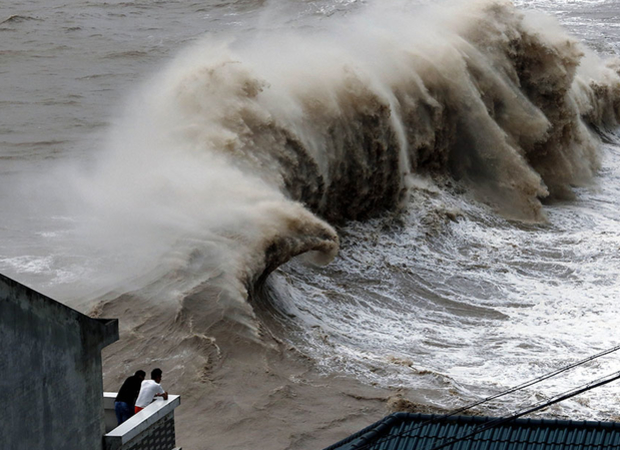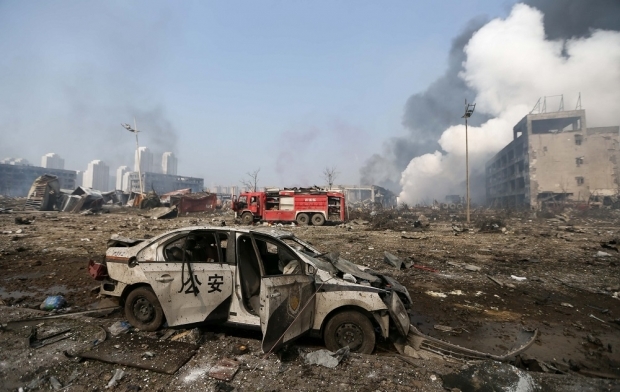Around 11:30 p.m., Beijing time, on Wednesday, at least two fearsome blasts in quick succession rocked the large northeastern Chinese port city of Tianjin. Originating at or near a hazardous materials warehouse near the city’s downtown, the conflagration and its shockwaves, which spread up to six miles, knocked over distant witnesses, blew the windows out of high-rise buildings, and, at last count, have killed at least 50 and injured 701, according to the latest count in Chinese official media. Thousands there have been rendered homeless.
But the power of citizen media is strong in Tianjin, a wealthy city with over 11 million inhabitants, many of whom wield smartphones. That empowers them to share photos, images, and posts almost instantaneously on mobile social platforms like WeChat and Weibo. Significantly, the latter is a public-facing network, allowing web users to share information and opinions with other users—even strangers—instantly. In the hours after the blast, sleepless users posted recordings of the blast, shared phone numbers of nearby hospitals, and advised other users where to go to donate blood and where to stay indoors if conditions were dangerous.
It’s also meant that in the day following the blast, Tianjin has become the locus of a national conversation about the disaster, and the government’s handling of it.
In times of crisis or disaster, Chinese information authorities move with great dispatch to shape public opinion, silence or deter open dissent, and generally project an image of technocratic confidence and national unity in the face of what it will inevitably insist is an unavoidable event, extrinsic to government control or fault. For example, in early June 2015, a cruise ship, the Oriental Star, capsized in China’s Yangtze river, killing over 400. Doubts initially swirled online about the regulation of the company operating the boat and the captain’s willingness to heed warnings about inclement weather, but they were quickly quashed, and the government succeeded in turning the disaster into a story of heroic divers racing against the odds.
Now, Chinese authorities are attempting a similar maneuver with the Tianjin blast, another event sufficiently horrific in its details that blanket censorship is impossible. China’s Cyberspace Administration has issued an order requiring websites to parrot from state media, and Tianjin authorities have banned editors and reporters from sharing news related to the blast on Weibo or WeChat. Meanwhile, Chinese state media have dutifully highlighted the heroism of its firefighters, and labored to assure observers that the government has the situation under control. But that hasn’t stopped China’s everyday citizens from using Weibo to question the official line. Here are the major questions they’ve been asking.
Should the warehouse have sat so close to residential districts?
On the afternoon of August 13, state broadcaster China Central Television (CCTV) live-broadcast a press conference with municipal fire safety and environmental officials to discuss the blast. In a moment captured here on YouTube, one reporter asked how far dangerous materials should be stored from residential areas according to environmental regulations. Wen Wurui, provincial environmental protection official, said there was “a standard limit,” but trailed off as the five men present looked at one another in apparent confusion. CCTV then cut back to the anchor, who sounded taken by surprise before regaining her composure and continuing her report.
Some of the most up-voted grassroots comments about the blast relate to the botched presser, with web users ridiculing the officials for “staring at one another” with the reporter’s question hanging in the air. An article released early on August 14, Beijing time, states that Chinese law requires a buffer around a chemical production plant at least 650 feet thick. It’s unclear whether the Tianjin port was in violation of any rules, but such a finding would threaten to spur the type of “NIMBY” (not in my backyard) environmental protests in Tianjin that have become a regular feature in many Chinese cities.
What is the actual death toll?
Because disasters like the Tianjin blast incur such grisly human costs, the release of death toll numbers are frequent sources of contention in Chinese social media, and observers frequently suspect that numbers are doctored downward. That can paint Chinese authorities into a corner. If they stay mum for too long, they risk seeming opaque; if they share too quickly, they will be accused of undercounting.
Media
07.20.15
Taming the Flood
Chinese authorities have released updated death tolls, only to be questioned at every turn from some corner of the Internet. After an initial report of seven casualties, one user fumed that hospitals were “scenes of chaos” and that the tally would surely be higher over time—another user had to remind him that the number referred to only confirmed deaths thus far. The more recent toll, of 50, is still facing doubters, with another writing “there’s no way to trust” a number under 100. “I’m not doubting the government, or the country,” he added. “But don’t we have a right to know?”
Is the air in Tianjin fit to breathe?
The New York Times reports that Tianjin residents “continued to wear disposable face masks throughout the day” following the disaster. That’s likely because many of them don’t believe half-hearted government exhortations that the air is safe. Shortly after the blast, one user noted that a warehouse for Rui Hai International Logistics, which handles potentially hazardous material, was in the blast area, “but I don’t dare speak freely because I’m scared I will get retweeted more than 500 times.” (Chinese law criminalizes certain “harmful information” that has been shared more than 500 times online.)
Several hours after the blast, the Tianjin police department wrote on Weibo that effluvium from the blast presented an “extremely small” danger, and that firefighters were delivering a “decisive blow” to the blaze. The top-voted comment to the post called the assurances a “lie.” Another popular response: “Bullshit. Everyone in the area can smell it.” Neither of those users claim to actually live or work in Tianjin, and it is unclear how they came upon their information—but their participation in the discussion is evidence of the national interest in the Tianjin disaster, and the potential for Internet chatter to ripple into the real world.
Is China’s government treating its firefighters properly?
Tianjin firefighters were quick to arrive on the scene, and 17 have so far been reported dead in their effort to quell the blaze. State media were quick to laud their courage and mourn their passing, in language and iconography suggestive of war heroes. Many said they were moved by the news, particularly reports that one firefighter, named Yuan Hai, was only 18 years old when he died.
Reverence for the firefighters did not stop some from accusing the government of mismanagement, or even indifference to firefighter safety. One popular comment complained that developed countries would not have sent firefighters into such peril, but instead waited for the fire to subside. Another fumed that “the higher ups wear safety hats” while the grassroots “sacrifice themselves for nothing—a classic problem with the system.” Another suspected the government was trying to manipulate public emotion by turning government workers into martyrs. “Before long,” he wrote, “people will forget this disaster, just like the forgetting of the Oriental Star accident. No one will be able to keep tabs on the investigation report, or whether those responsible will be found. Next time a tragedy happens, people will again fill their screens with candles,” and, he implied, little more.
Jordana Cepelewicz contributed research.




